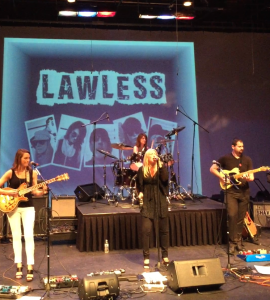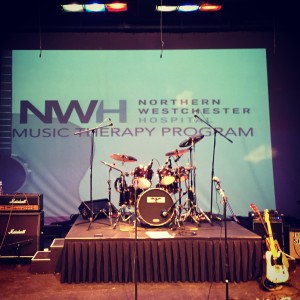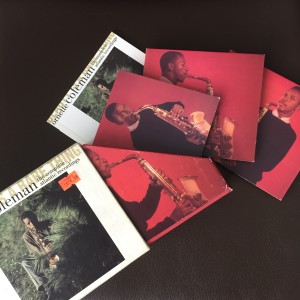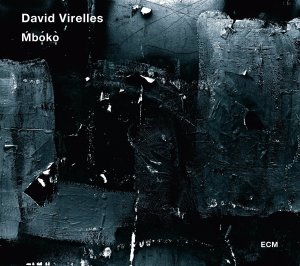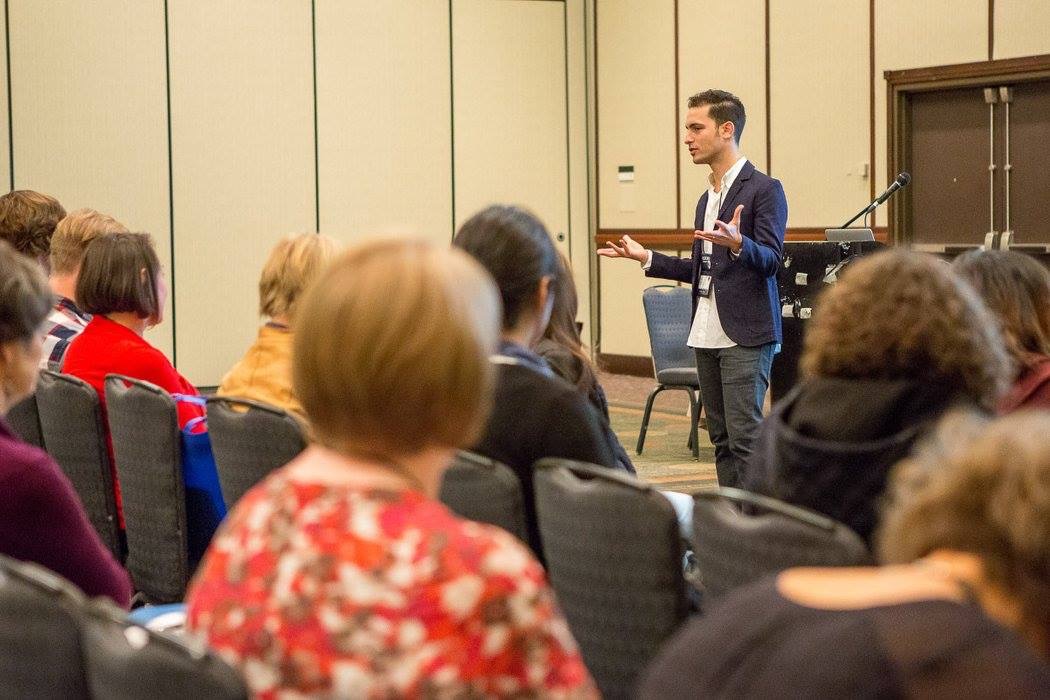
Latin Rhythms at AMTA 2015
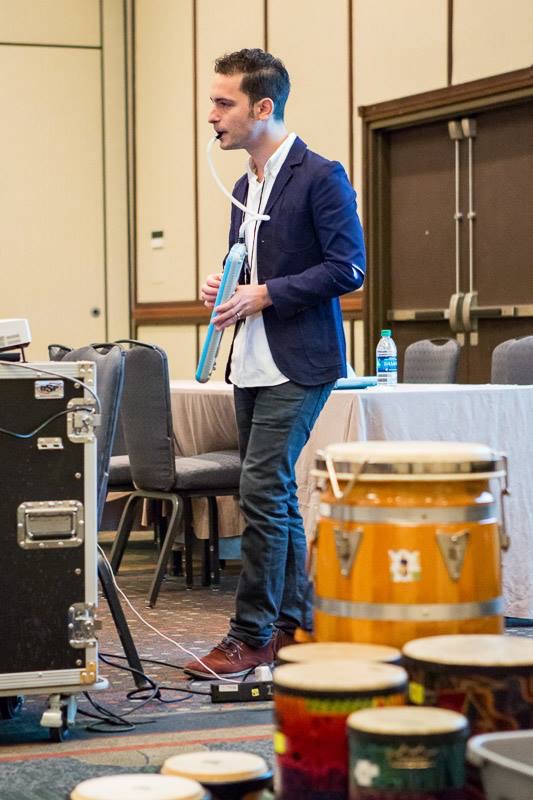
Every year, the American Music Therapy Association holds a national conference where the music therapy community meets to discuss the latest advancements in our field and make important decisions that pave the way for the present and future of the profession. I love attending these conferences because it helps me remain acquainted with the latest research. It also gives me an opportunity to learn from others, share my experience, and grow as a clinician through the many enlightening discussions and conversations I get to have with my brilliant friends and colleagues.
This year the conference was held in Kansas City, and I had the honor of presenting about Latin rhythms and how they can be used clinically.
[/x_text]I was glad to have a fantastic turn-out of about 70 music therapists from around the country. We discussed the importance of taking culture-specific considerations when working with our clients, and focused on the incredibly diverse and influential Latin community. We briefly touched on major musical styles from Latin America, yet spent most of our time looking closely at rhythms based on clave such as Son Montuno, Cha-cha-cha, and Bolero. Participants got a chance to understand, play, and experience the different components of these fun intricate rhythms. We proceeded to discuss how we can use these material with Latin and non-Latin clients in different music therapy settings. We all had an absolute blast and came out dancing with our enriched musicality. Check out the video on the right to get a glance at our experience! To learn more about Latin Rhythms in music therapy click here.
[/x_text]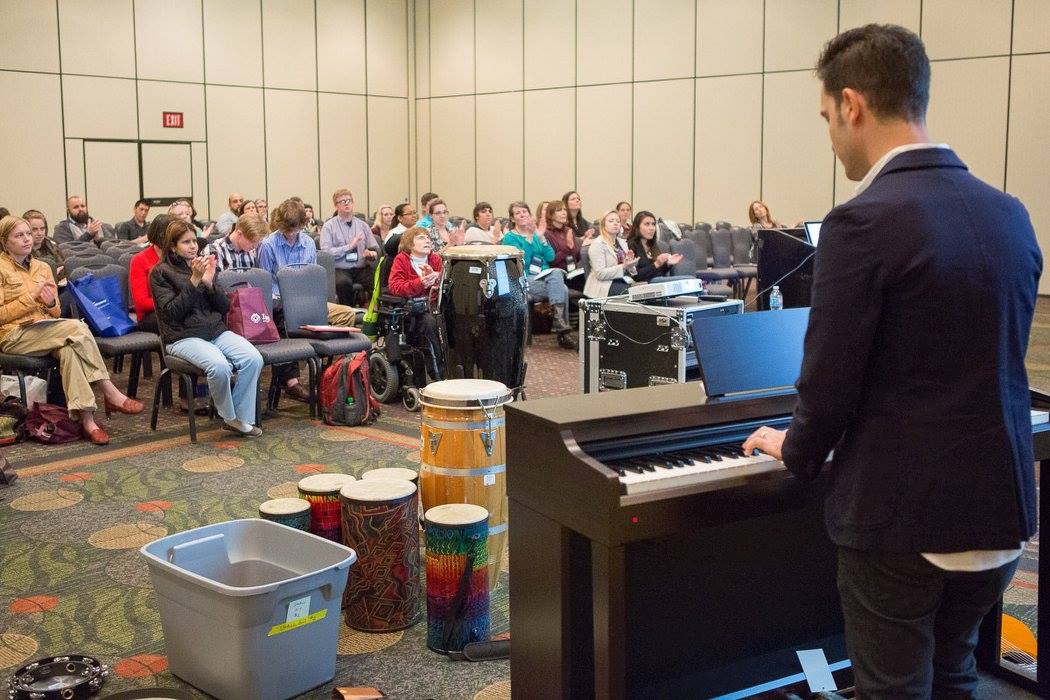
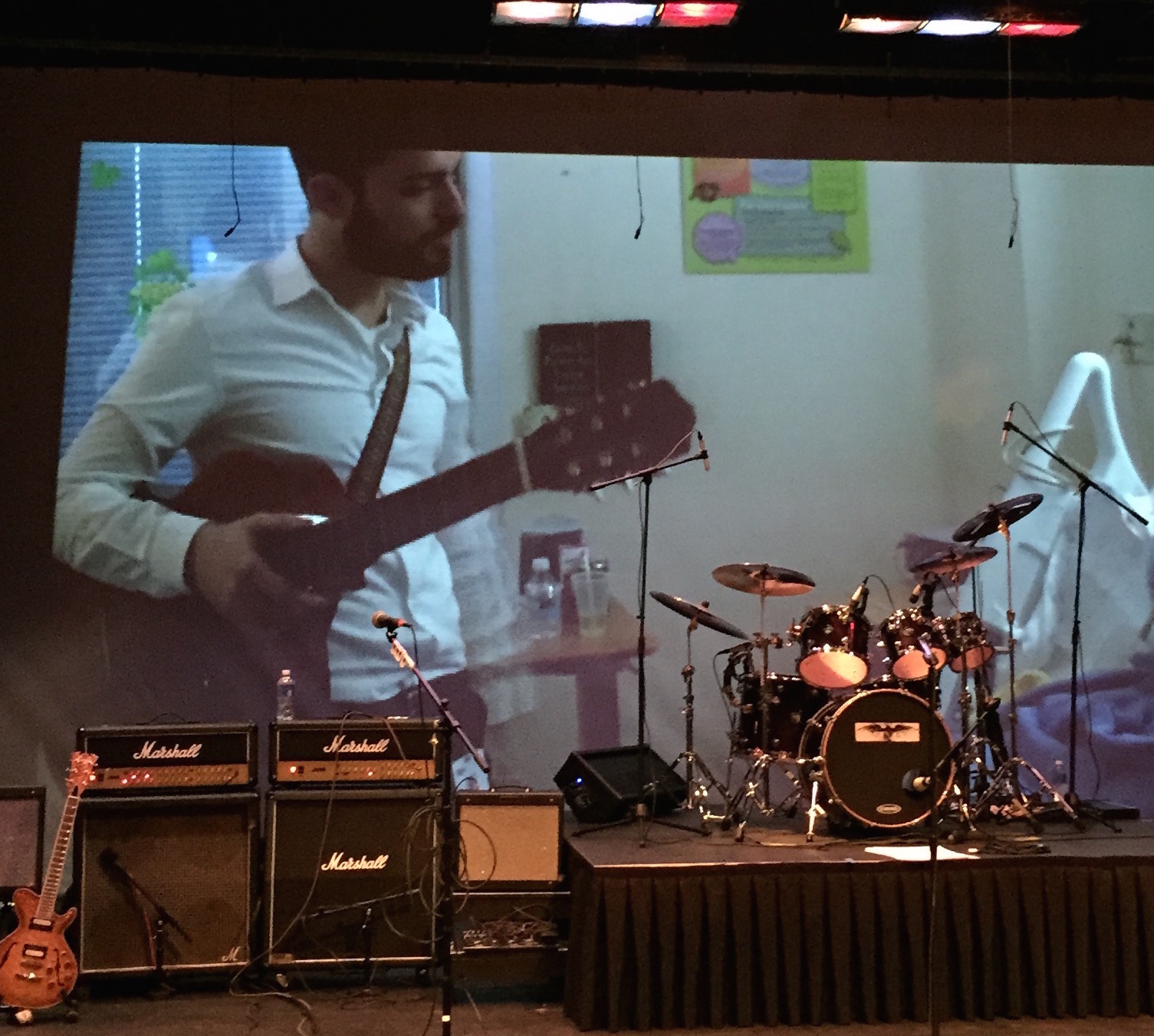
Northern Westchester Rocks for Music Therapy
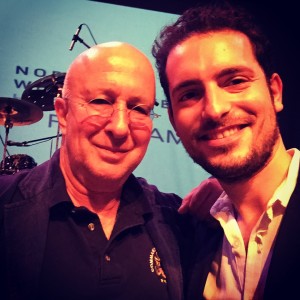 We had an incredible time at the annual Moms and Dads Rock For Music Therapy concert that helps support our program in Northern Westchester Hospital, held at the beautiful Harvey School in Katonah, NY.
We had an incredible time at the annual Moms and Dads Rock For Music Therapy concert that helps support our program in Northern Westchester Hospital, held at the beautiful Harvey School in Katonah, NY.
The lineup consisted of the excellent bands Lawless, ONL, and The Shaves, along with a special appearance by the amazing Paul Shaffer. Comedienne Christine O’Leary bridged the acts together, as Cathy and Paul Shaffer, and Anita and John Bae, hosted the wonderful evening in collaboration with the Northern Westchester Hospital Foundation.
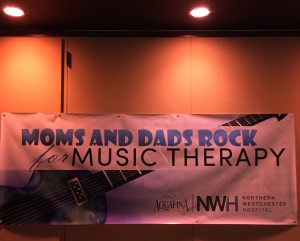 It is an absolute honor to work with a community that is so eager to make a difference in the quality of life of its members. I can proudly say that we are building something special together.
It is an absolute honor to work with a community that is so eager to make a difference in the quality of life of its members. I can proudly say that we are building something special together.
I want to take the opportunity to give special thanks to Cathy and Paul Shaffer, Joel Seligman, Maria Hale, Keeva Young-Wright, and Whitney Wasserman, for their dedication to music therapy and their trust in Berko Music Therapy. To Susan Raskin, Tony Russo, Carolyn Szala, and Joanie O’Keefe, who work with me every day. And to all the doctors, therapists, nurses, and receptionists, who collaborate with us, cheer us at our arrival, and believe in the work we do. The following video was shot by Ben Sultan and edited by Sue Lacolla, and is just a grasp of what goes on in the hospital every week.
Below are a few more images of the night. Thanks again to the sponsors, bands, hosts, and attendees for making it happen.
For more coverage of the event please visit: https://www.allaboutbedford.com/harvey-school-14-15.html
Learn More
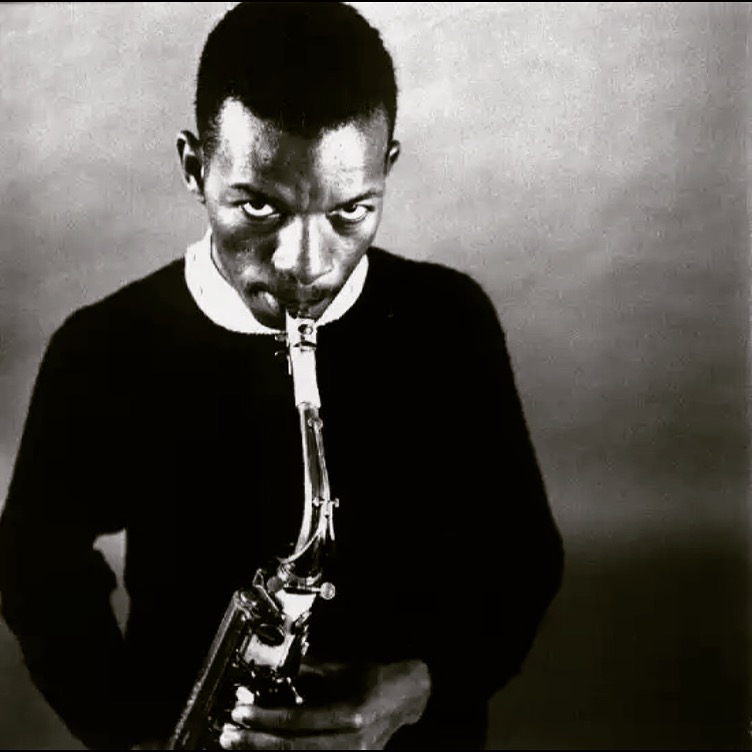
Ornette Coleman and Music Therapy
Ornette Coleman, one of the most legendary and influential musicians of all time, passed away on June 11th, 2015, at the age of 85. I first heard of Ornette when my teacher Omar Tamez got me into all these amazing jazz albums back in Monterrey, Mexico. I also remember that during my first year at Berklee College of Music, there was a time when I couldn’t stop listening to the “Beauty is a rare thing” box set I bought at one of the CD stores around school. It was the summer of 2006, and I remember this music had a big impact on me, as I searched for my own identity while living in a new country within the structure of formal music education.
The music of these records really moved me. It felt so organic, honest, and personal. I loved the melodies, the interaction, the feel. One of my favorite pieces was “Una Muy Bonita” (1960), which featured the ‘original quartet’ formed by some of my favorite musicians (Ornette Coleman-sax, Don Cherry-trumpet, Charlie Haden-bass, and Billy Higgins-drums).
Ornette is regarded as one of the pioneers of free jazz, partly because of his album “Free Jazz” (1960), in which there are two quartets playing together.
https://youtu.be/xbZIiom9rDA
But even if regarded as a pioneer of free jazz, Ornette’s work still relied heavily on composition. These were often melodies without a set sequence of chords, played by a band without a piano player. Ornette liked to improvise without feeling confined to a pre-conceived harmonic structure, and his play in between notes was often perceived as out-of-tune by colleagues and critics.
https://youtu.be/bJULMOw69EI
The day Ornette passed away, his influence was felt on many circles in social media, where countless people expressed gratitude and admiration for his life and vision. Many of the comments stated by musicians and artists identified Ornette as an influential source of inspiration in their own search for authenticity. Guitarist Pat Metheny wrote about it 16 years earlier in the preface to the book Ornette Coleman: His life and music by Peter Niklas Wilson:
“He has inspired me -and by this time it must be thousands of other musicians- to answer to a standard that demands that we look into our own hearts and minds to see what we may have to offer in our own personal musical languages -if we can only muster up the courage to listen to the songs inside of us the way Ornette has done.” – Pat Metheny
The process of exploring our authentic musical self is something we often work with in music therapy. At Berko Music Therapy, we often help people access the music resources they have acquired throughout life, whether their experience includes any form of training or not. This often results in a creative process where people play instruments they have never played before, which can facilitate a deep level of introspection, self-expression and genuineness. Perhaps Ornette was thinking along those lines when playing violin and trumpet, instruments in which he had no formal training.
https://youtu.be/y09k4zyIfO8
One of the things that separated Ornette from other musicians was his uncanny ability to create his own world. Much like a Miro, or a Pollock, he defined his own rules and reached a very unique and personal level of creative expression while defying established artistic and societal norms and mediums. We can learn a lot from the expansive ways in which Ornette thought about music. In the following interview, he at times almost sounds like a music therapist.
“My real concern for the things that I would like to perfect in music is to heal (suffering, pain, solitude), when you are depressed, music seems to be a very good dose of light that causes people to feel a lot better.” -Ornette Coleman
More selected videos:
Learn More
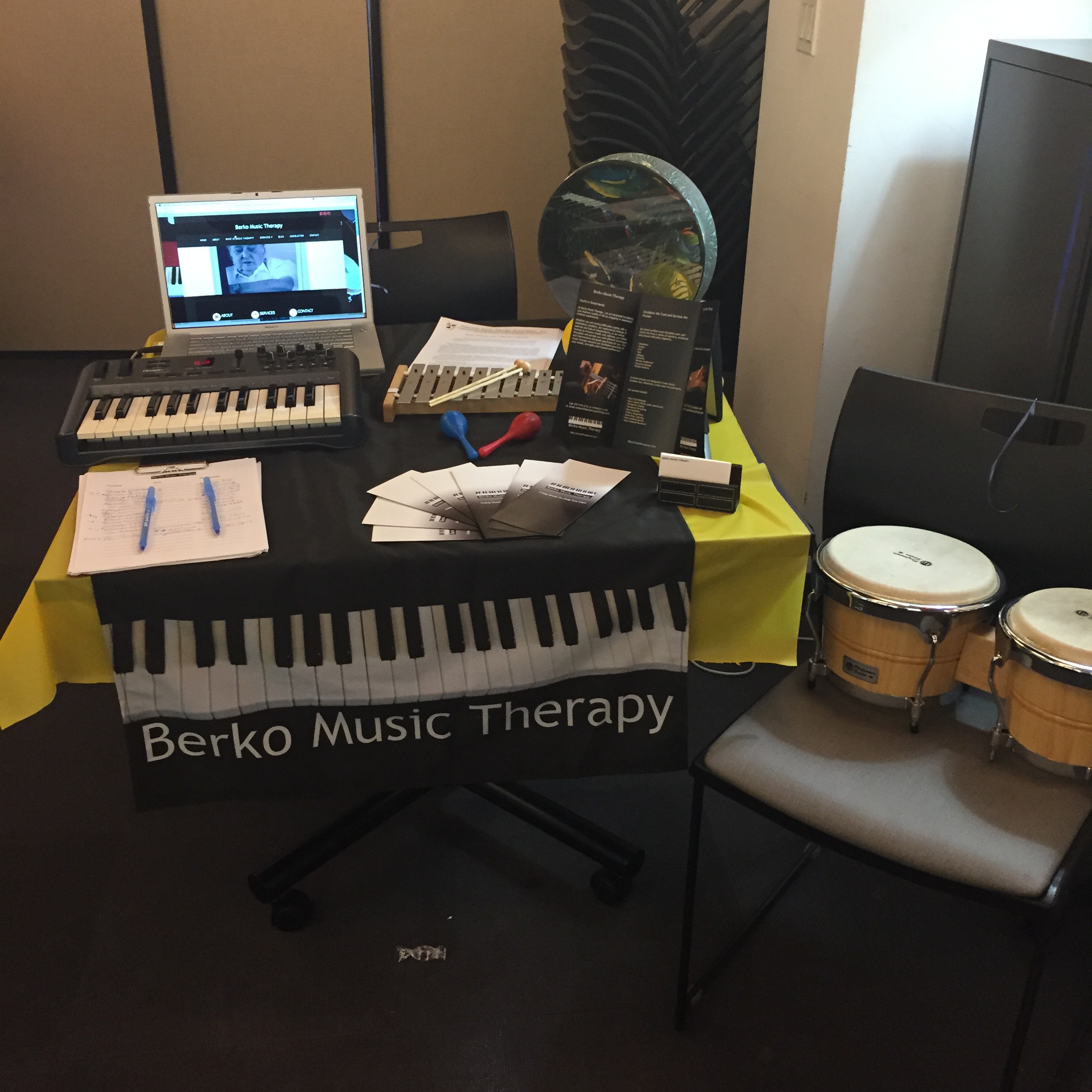
Community Health Fair
We recently participated in a wonderful holistic health fair hosted by Stein Senior Center. We were invited along with other healthcare providers, and had the opportunity to chat with members, families, and clinicians about how music therapy can help the community. The instruments displayed were hard to resist and improvised jams naturally emerged from numerous interactions. Once again it is evident that the power of music is immediately available for those who dare to use it.
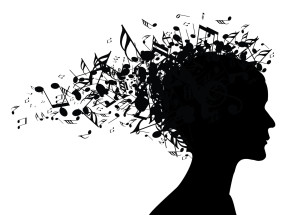
To learn more call us at 347-774-1712 or email us below.
[contact_form]
A Music Therapist on Skis
I recently had the opportunity to go skiing for the first time. At first I was unsure whether attaching metal to my feet to slide down on snow from the top of a mountain was a terrible or very good idea. The astonishing beauty of the surrounding landscape helped me go with the latter.
I was amazed at the amount of people of all ages that come from all parts of the world to do this. Each one at their own level of mastery. There are 7 year old experts and 60 year old novices. There are adaptive opportunities for individuals who are blind or paraplegic.
My experience began in ski school. An instructor taught me to maintain balance, to stop, to turn. I felt good about my progress and got a lot from every part of the process.
Eventually I made it down the mountain. At many points I lost my balance fearing I would crash against a tree or fall down the abyss. At times I stopped thinking and allowed myself to feel my existence within nature.
Once while taking the lift with the instructor, she told me that she always wanted to play an instrument but never really tried because she has no talent. This is something that us music therapists hear quite often. A lot of people actually think that you need to have some magical talent to play music. It is true that there are a lot of ridiculously talented musicians. Some might even be geniuses. But most people who play music are not even professional. You don’t necessarily have to try to make a living out of it. Just like most people here are not even trying to make it to the Olympics. Some take it more seriously than others and some are actually pretty good. But even those of us who spend half the time on our butts can have a meaningful experience.
My next time down I let myself go a little bit more and was able to maintain much better balance. I was able to focus my awareness on the present moment and enjoy the process. Even at 2 miles per hour, on flat ground, the snow still absorbs the sound and the quiet is accompanied by these endless ice cream mountains.
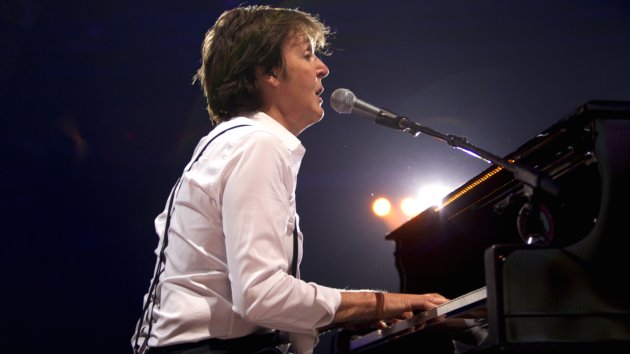
Songs for Valentine: Which one are you?
There are infinite ways to express love and romance through song. Which one fits YOU best? How do YOU say I love you? Simple and straightforward or abstract and complex? Are you more about sweet and colorful romance or dark and sort of weird? Rainbows and butterflies or bones and flesh? Jump of joy or stare out the window? Open arms free fall or careful meticulous rocky mountain way down? The great American songbook, Motown, folk, Latin, punk, 80’s power-ballad or modern pop? Are you more Paul or John? Ella or Billie? Marvin or Al? Bjork or Beyonce? Go through the following playlist and notice which one resonates with you the most. Share it with your friends and lover(s)!
Learn More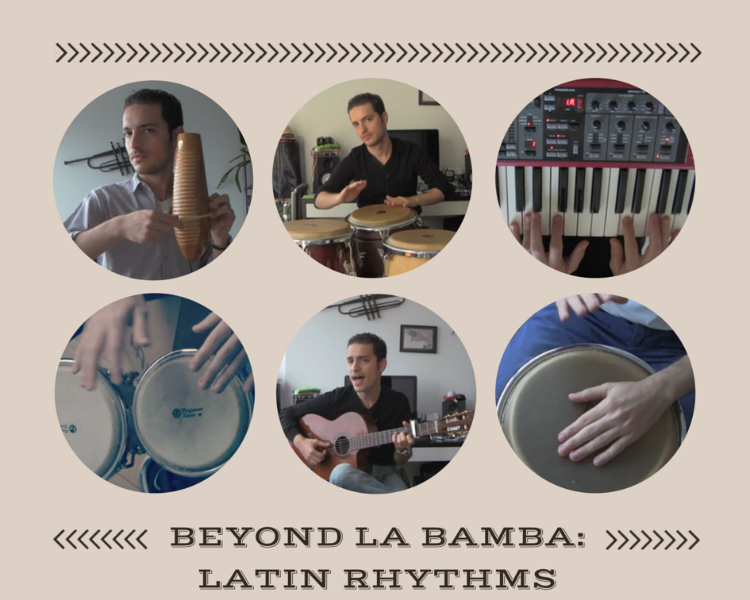
Spicing it up with Latin Rhythms at Music Therapy Ed
I recently released a CMTE course with one of the leading online resources for music therapists, Music Therapy Ed. The course is called Beyond La Bamba: Latin Rhythms, and it was created to help music therapists develop skills to connect with clients and patients who have a preference for Latin music.
I was exposed to a lot of great Latin music while growing up in Mexico and while studying at Berklee College of Music. I have also been fortunate enough to work with a vast amount of clients and patients of Latin background while living in New York City for the past ten years, and I am thrilled to have the opportunity to pass along some of the information I have acquired.
Beyond La Bamba: Latin Rhythms with Ariel Weissberger, MA, MT-BC from Kathryn Fulton on Vimeo.
Unlike an artist who expresses his own personal feelings, stories thoughts and points of view through his art, a music therapist focuses on the client’s own experience. Within a therapy session a music therapist is as unlikely to play a personal break-up song per se, as a psychoanalyst is to talk about his own mother. In other words, the music therapist’s music is about the clients, and its role is to facilitate music experiences by bringing out the music in them while working on musical and non-musical clinical goals. This puts us music therapists in a position where we are constantly learning new songs and styles of music in order to have as many tools as possible to do our job. It also speaks volumes about the amount of effort, care and dedication we put into our work.
Latin styles of music are an essential part of the music therapist’s toolbox not just because the Hispanic population is the largest minority in the US, but also because Latin music is extremely popular among non-Latin people. Furthermore, Latin rhythms are quite present in a lot of music genres of today’s eclectic world.
Latin rhythms can be challenging but are also highly engaging. The mere task of working on them can positively impact the rhythmic sense and overall musicality of any musician. If you are a music therapist, music educator or musician looking to get started on Latin rhythms to spice up your music, I invite you to join the course by clicking below. Are you up for the challenge?
Learn More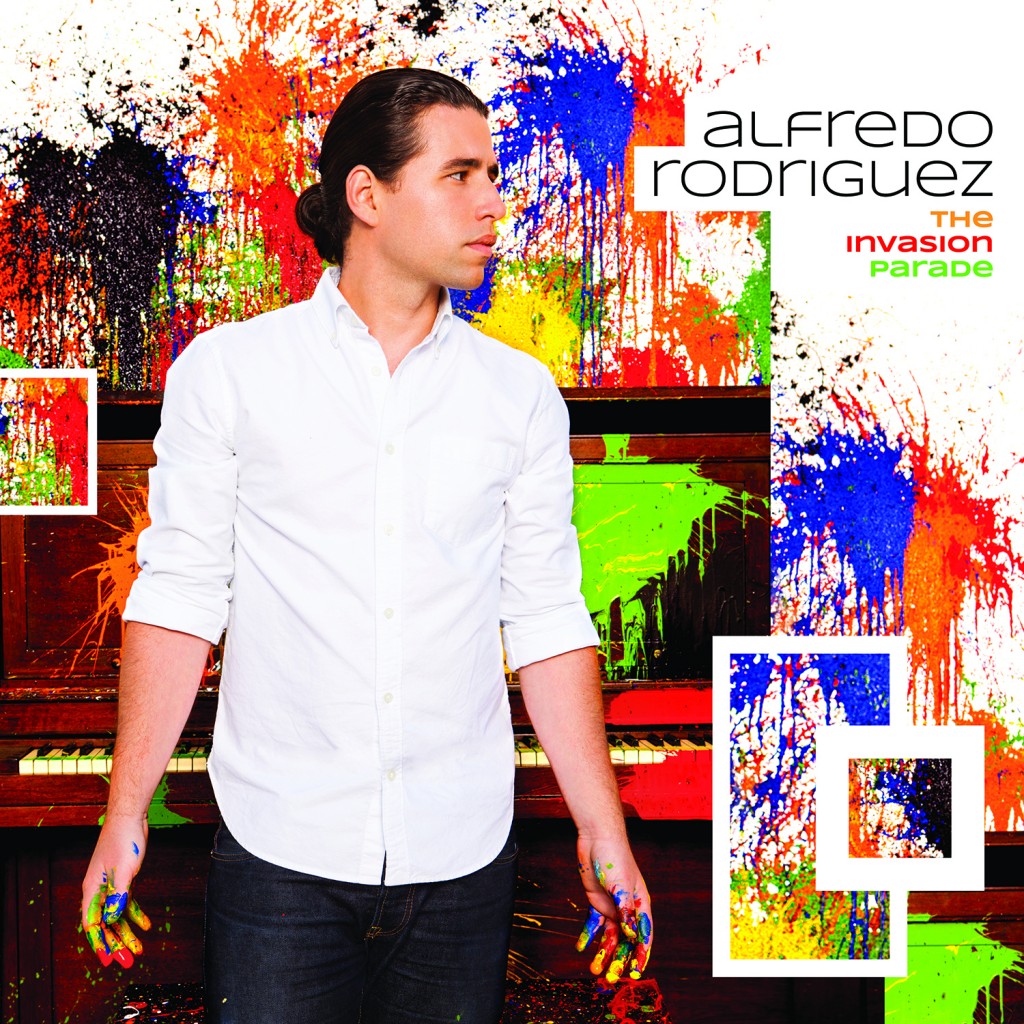
Top Albums of 2014
There is so much amazing music out there today. This is a list of my own personal favorite albums of the year. It includes 3 albums from the current popular jazz scene (obsessed with cameo vocals, spoken word and mixed genres), 2 modern Cuban pianists (one of which fits the current jazz scene mantra), a major rock/pop artist, a vocalist, a soundtrack, a Jewish Afro/punk band, and a beautiful tribute album.
1. The Invasion Parade by Alfredo Rodriguez
This is the album that got me the most excited this year. The cover is fitting as Cuban pianist Alfredo Rodriguez does in fact sound like a mad prolific painter. He tends to switch colors and emotions quickly, maintaining a level of intensity that keeps you hooked and unable to let go. The primary lineup is rounded by Henry Cole, Peter Slavov, Billy Carrion, and Roman Filiu. Percussionsit Pedrito Martinez and bassist/vocalist Esperanza Spalding are guests in some of the songs including the absolutely beautiful ‘El Guije’ and ‘Snails in the Creek’ (the former in particular has some ridiculous vocals by Esperanza). ‘Santa Barbara’ and ‘Timberobot’ will have you jumping off your seat, while the classics ‘Quizas, Quizas, Quizas’ and ‘Veinte Anios’ are treated more delicately but with the same level of intensity. The number one highlight of the album has to be this insane rendition of ‘Guantanamera’.
itunes link: https://itunes.apple.com/us/album/the-invasion-parade/id785831390
2. Morning Phase by Beck
This is a very emotional album similar to Sea Change from 2002. If you are feeling sad, it will drag you to the ground. Yet unlike Sea Change, Morning Phase does include moments that may feel potentially uplifting within the right context. It is more complex in that regard and to me it is Beck’s best album to date. The instrumentation is mostly basic with a lot of strings, colorful arrangements and subtly slick production. It has an overall sense of simplicity, openness and warmth. Beck’s songwriting feels genuine and so does his singing. Among the albums highlights are ‘Morning’, ‘The Heart is a Drum’, ‘Say Goodbye’, and ‘Blue Moon’ (otherwise known as the song from True Detective‘s last episode from season 1).
itunes link: https://itunes.apple.com/us/album/morning-phase/id797897966
3. The Imagined Savior Is Far Easier To Paint by Ambrose Akinmusire
The follow up to the band’s incredible album debut When the Heart Emerges Glistening is another success for this brilliant trumpeter. This one is perhaps darker and more spiritual. The album is a good representation of the jazz scene today; broad in instrumentation and genre, with different vocalist appearances. Singer Becca Stevens steals the show for a moment on this one with the thought-provoking ‘Our Basement’. The band sounds like if it has been playing together for 30 years. I particularly love how Ambrose and saxophonist Walter Smith iii blend together.
itunes link: https://itunes.apple.com/us/album/imagined-savior-is-far-easier/id816479578
4. Big Picture by Kat Edmonson
The incredibly expressive Kat Edmonson has quickly become one of my absolute favorite singers. She will quickly draw you in and hypnotize you before you even realize what is happening. At times she may sound like Billie Holiday and at times like the girl from Cranberries, but she never loses her own unique characteristics. An incredible voice with infinite nuances and an uncanny ability to deliver her heartfelt songs in such personal way that it feels she is singing only to you.
itunes link: https://itunes.apple.com/us/album/the-big-picture/id898060389
4. Mboko by David Virelles.
It should be noted that the subtitle of this album is Sacred Music for Piano, Two Basses, Drum Set and Biankoméko Abakuá, which tells you the instrumentation but also the vibe of the album. The Cuban pianist is joined by Roman Diaz, Marcus Gilmore, Thomas Morgan and Robert Hurst. This music requires your full attention. It is sparse and abstract with almost no melody and no groove (at least in the traditional sense). The band is instead mostly preoccupied with interaction, texture and space. Arguably the most interesting album I heard all year. *ECM record label does not have their albums on spotify so you most go to itunes to listen to it.
itunes link: https://itunes.apple.com/us/album/mboko/id923382031
6. Heroes and Misfits by Kris Bowers
Another modern Jazz album from the current scene as described above. Pianist Kris Bowers takes this idea to the extreme. This is indie rock, r&b, hip-hop, electro, jazz. Some really cool grooves, vibes, and textures make this a fun and engaging listen. From the albums that came out this year, this may be the one I listened to the most.
itunes link: https://itunes.apple.com/us/album/heroes-+-misfits/id779473938
7. Birdman by Antonio Sanchez
This is the soundtrack of the movie by Mexican director Alejandro Gonzalez Inarritu, who had the brilliant idea of asking his fellow countryman drummer Antonio Sanchez to write it/play it strictly on drums. This gives a very unique feeling to the movie that puts you inside the crazy head of the main character, who is brilliantly portrayed by the surprising Michael Keaton. Antonio is one of the most sought after and well respected drummers in the world and tends to play very clean and perfect. Yet on this album, he purposefully plays these de-tuned drums and sounds ‘dirtier’ than you will ever hear him. Antonio arrived in Hollywood and raised the name of Mexico, drumming and Jazz altogether. I believe he deserves an Oscar.
itunes link: https://itunes.apple.com/us/album/birdman-original-motion-picture/id922241290
8. Adramelech by Zion 80
This is one of the many many many projects involving John Zorn. The music is written by this prolific and ridiculously productive musician as part of Masada Book Two. Zion80 plays it and delivers, leaving no doubt that they are a thing on its own; A fantastic Afro/Punk/Reggeae/Heavy Metal/Jazz/Jewish/Klezmer band.
itunes link: https://itunes.apple.com/us/album/adramelech/id900627625
http://youtu.be/-kbna5-_MGA
9. The Thought Of You by Otis Brown III
This is the album debut of drummer excellence Otis Brown III. It is the 3rd of the ‘current Jazz scene’ type of thing album of this list.The underlying tone of this one is more traditional as compared to the other two, at times bringing to mind Miles’ 2nd Quintet. Of course, vocalists are present on some of the tunes including the fascinating Bilal Oliver. Spoken words are also present including the actual audio recording from Otis’s very own wedding on “The Two Become One (For Paula)”. Otis is an explosive drummer who continuously explores highly energetic groove changes with contagious excitement.
itunes link: https://itunes.apple.com/us/album/the-thought-of-you/id898129099
10. Beautiful Life by Jimmy Greene
Saxophonist Jimmy Greene recorded this album as a tribute to the life of his 4 year old daughter, a victim of the Sandy Hook Elementary School shooting in Connecticut in 2012. Mr. Greene has often stated that he wanted the music to represent the way her daughter Ana lived, as opposed to the way she passed away. It is naturally a very touching beautiful album that includes the participation of a vast number of highly acclaimed musicians. This next peace opens the album. It starts with a home recording of Ana and friends singing a Puerto Rican song, followed by a Pat Metheny /Jimmy Greene duet, followed by another home recording of Ana singing while her brother plays piano. All in all it is a very touching album that illustrates the power of music as a coping, celebratory, unifying tool.
itunes link: https://itunes.apple.com/us/album/beautiful-life/id924565924
Other good ones:
Lathe Of Heaven by Mark Turner Quartet, Taming The Dragon by Mehliana, Beat Music: The Los Angeles Improvisations by Mark Guiliana, You’re Dead by Flying Lotus, …And Then You Shoot Your Cousin by The Roots, Golden Age by Nir Felder, Vipassana by Eric Harland, Landmarks by Brian Blade & The Fellowship.
*You can access the spotify playlist of all these songs (including ‘other good ones’ but excluding those not available on spotify) by following it here: favorite albums of 2014 spotify playlist
Learn More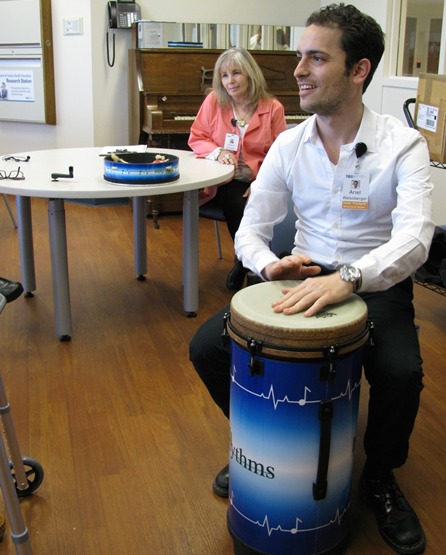
Back in Northern Westchester Hospital
Berko Music Therapy is back in Northern Westchester Hospital with a new revamped music therapy program in collaboration with patient advocacy and integrative health departments. Based on the Planet Tree award-winning program we were previously involved with at the same facility, we are providing individual and group music therapy sessions for inpatient psychiatry, adult inpatient rehabilitation, post-surgery and general hospital units.
We are working within the clinical goals of each patient in order to help achieve maximum gains in treatment, accelerate recovery and cope with hospitalization.
Among the supporters of the program are Cathy and Paul Schaffer (David Letterman’s musical director).
The following is an interview published in the Journal News with vice president of patient advocacy and patient centered services Maria Hale, who discusses the impact of the program.
http://www.lohud.com/story/news/2014/06/23/music-therapy-benefits-hospital-patients/11271557/

Miles Davis – Adapting Through Time
Miles Davis was born on May 26th, 1926, in Alton, Illinois. He would go on to become one of the most celebrated artists of all time through an illustrious career as a trumpet player, jazz musician, composer, and bandleader. Recently on the 88th anniversary of his birth, the street where he used to live in Manhattan’s Upper West Side was renamed ‘Miles Davis Way’.
To honor that, we will look at one of his greatest traits: the ability to understand and adapt to his surroundings through time.
Perhaps similarly to Picasso or Bob Dylan, Miles remained on the edge by changing styles and approaches multiple times, depending on what was happening in the world around him.
He continuously surrounded himself with the brightest young musicians of the time. John Coltrane, Wayne Shorter, Herbie Hancock, Tony Williams, Keith Jarrett, Chick Corea, Jack Dejohnette, Dave Holland, were among those hired at a young age by Miles before going on to become huge names themselves.
Let’s look at a brief summary of the different periods of his career.
Bebop; The early beginnings. (mid 40’s)
At 18 years old, Miles Davis moved to New York City to attend Julliard School of Music and meet his heroes Charlie Parker and Dizzy Gillespie. He soon got to play in Parker’s band.
Becoming A Leader (late 40’s, early 50’s)
Miles was an innate leader and quickly started recording his own albums with the best musicians in town.
https://www.youtube.com/watch?v=gHKnvwoGg0Y
Orchestra (Late 40’s and late 50’s)
He collaborated with the brilliant arranger Gil Evans in an orchestral setting. Together they recorded beautiful albums like Birth of The Cool, Porgy and Bess, Sketches Of Pain and Miles Ahead.
https://www.youtube.com/watch?v=lvcU_v8ruGE
First Quintet (Mid 50’s)
The first quintet was his first great band. It had what many consider to be the greatest rhythm section of all time with Philly Joe Jones (drums), Paul Chambers (bass) and Red Garland (piano). It also had John Coltrane. Miles and Coltrane were very different and created an exciting contrast. (Coltrane comes in at 2:35).
Kind of Blue (Late 50’s)
Coltrane was still in the band but the rhythm section changed. The band got into modal music with very few chords and basically only one scale. This is a live version of “So What”, a tune from , Kind of Blue, one of his most famous albums.
Second Quintet (mid sixties)
At this point Miles had a completely new band with Tony Williams (drums), Ron Carter (bass), Herbie Hancock (piano) and Wayne Shorter (sax). Coltrane and Ornette Coleman were among those playing freer forms of jazz with their own bands. Miles incorporated certain aspects of free jazz with this band. This is also one of the greatest rhythm section of all time.
Electric (70’s)
Miles would not pass the opportunity to play for huge crowds when electric instruments and amplification made it possible. He decided to go electric and play open rock grooves. The album Bitches Brew is from this time. This is at Isle of White festival.
http://youtu.be/GmJwV3Xkl8M
80’s
Miles embraced the decade and got into the vibe of the time. He played several hits including Michael Jackson’s Human Nature.
In 1991, Miles died of health complications at the age of 65. What would Miles be playing today? The question will forever linger.
Learn More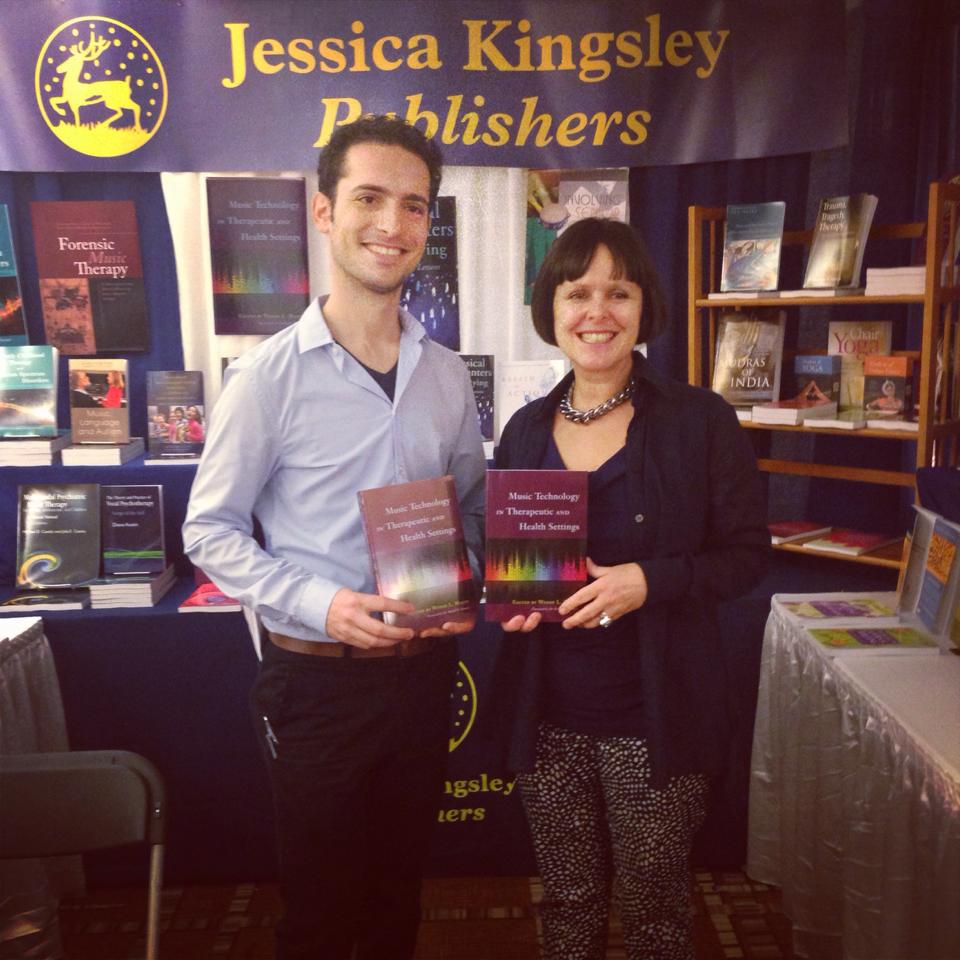
Published! – On Music Therapy and Technology
I have the honor to be featured in Dr. Wendy Magee’s new book called Music Technology in Therapeutic Health Settings, published by Jessica Kingsley Publishers, one of the top publishing companies in the field .
Dr. Wendy Magee is a world renown professor, researcher and music therapist. For this project, she recruited a number of music therapists currently doing breakthrough work with music technology, and asked each to write a chapter about it.
I wrote chapter 15. Garageband as a Digital Co-Facilitator: Creating and Capturing Moments with Adults and Elderly People with Chronic Health Conditions.
 In this chapter I talk about how I used Apple’s music software Garageband in a music therapy group I ran for Spanish speaking registrants at an adult day health center in Bronx, NY. This was one of the many programs I had the opportunity to design and implement while working with the Institute for Music for Neurologic Function. The group recorded a full album of original songs as part of their creative therapeutic process.
In this chapter I talk about how I used Apple’s music software Garageband in a music therapy group I ran for Spanish speaking registrants at an adult day health center in Bronx, NY. This was one of the many programs I had the opportunity to design and implement while working with the Institute for Music for Neurologic Function. The group recorded a full album of original songs as part of their creative therapeutic process.
Perhaps my central argument is that technology not only can facilitate musical, creative and therapeutic processes, but also help adults and elderly feel connected to the current trends in the world surrounding them. In this group in particular, members have at least three barriers that are potentially isolating: culture, age and health related. The use of technological devices such as laptops and ipods may at least partially diminish a little bit of each.
A number of participants in the program reported feeling more connected to their younger family members after gaining a better understanding of current technology related cultural trends. They were also able to work together relying on each other’s strengths to minimize their weaknesses. A stroke survivor with a speech deficit was able to thrive in the group due to her intact memory, while a woman with early stages of dementia was able to utilize her great diction to contribute to the group in spite of her deteriorating memory skills.
With the use of technology we were able to capture the meaningful moments we created, maximize them and reflect them back. The production of the album provided the context in which we relied on for guidance and purpose. In the chapter, I describe some techniques implemented to support, fulfill and magnify the creative ideas of the group. Such techniques include overdubbing, multi-tracking, and looping.
I am hoping some of these ideas can add something to the ever present yet increasingly pertinent discussion of technology related issues in the field. What is our role as music therapists/album producers? How much should we add our own aesthetic ideas? How much do we ‘fix’ notes and mistakes? What are some counter-indications to the use of technology?
Congratulations to Dr. Wendy Magee for putting together this extremely important book, to Dr. David Ramsey -who I consider my mentor- for his genius foreword, and to all the brilliant music therapists who wrote and participated. I am thrilled to be a part of it!
You may order the book directly at Jessica Kingsley Publishers or at Amazon.
Learn More

Top 10 Albums of 2013
There is a lot of fantastic music out there and it is always tough to leave some out.
The following is a list of my personal favorites that came out in 2013.
1. Wayne Shorter, Without A Net
Wayne Shorter-sax, Danilo Peres-piano, John Patitucci-bass, Brian Blade-drums
2. Kanye West, Yeezus
3. Dave Holland, Prism
Dave Holland-bass, Kevin Eubanks-guitar, Craig Taborn-keyboard, Eric Harland-drums
4. The Pedrito Martinez Group, The Pedrito Martinez Group
Pedrito Martinez-congas/vocals, Ariacne Trujillo-piano/vocals, Alvaro Benavides-bass/vocals, Jahir Sala-percussion/vocals
5. The New Gary Burton Quarter, Guided Tour
Gary Burton-vibraphone, Julian Lage-guitar, Scott Colley-bass, Antonio Sanchez-drums
6. Derrick Hodge, Live Today
7. Drake, Nothing Was The Same
8. Albert Heath/Ethan Iverson/Ben Street, Tootie’s Tempo
Albert Heath-drums, Ethan Iverson-piano, Ben Street-bass
9. Kendrick Scott Oracle, Conviction
Kendrick Scott-drums, Mike Moreno-guitar, Taylor Eigsti-piano, John Ellis-reeds, Joe Sanders-bass
10. Cecile Mcloren Salvant, Woman Child
Cecile Mcloren Salvant-vocals, Ahron Diehl-piano, Rodney Whitaker-bass, James Chirillo-guitar, Herlin Riley-drums
Other great ones: Chris Potter/The Sirens, Craig Taborn Trio/Chants, Antonio Sanchez/New Life, Atoms For Peace/Amok, Eric Revis Trio/City Of Asylum, Dave Douglas Quintet/Time Travel, Ethan Iverson/Customs Are Mandatory, Tim Berne’s Snakeoil/Shadow Man
Learn More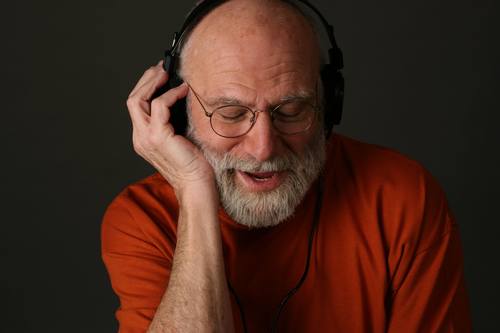
Oliver Sacks’s Life Lessons
A few weeks ago, the great neurologist/writer Oliver Sacks reflected in a New York Times column on the experience of turning 80 years old.
He embraces the new experience of approaching the end of his life.
“I often feel that life is about to begin, only to realize it is almost over.”
Learn More
Classic Renditions Of The Star Spangled Banner
Performances of the American national anthem are often surrounded by all sorts of controversy. The traditionalists believe that a patriotic anthem should not be disrespected with personal stylistic alterations interpreted by the performing artist. Others argue that the freedom and individuality conveyed by the interpreter may symbolize the core values the country was founded on. Either way, the music can be challenging to sing because of its melodic shape and not-so-easy-to-remember lyrics. It is often performed in widely broadcasted events, and thus we have some interesting performances captured for the ages. (more…)
Learn More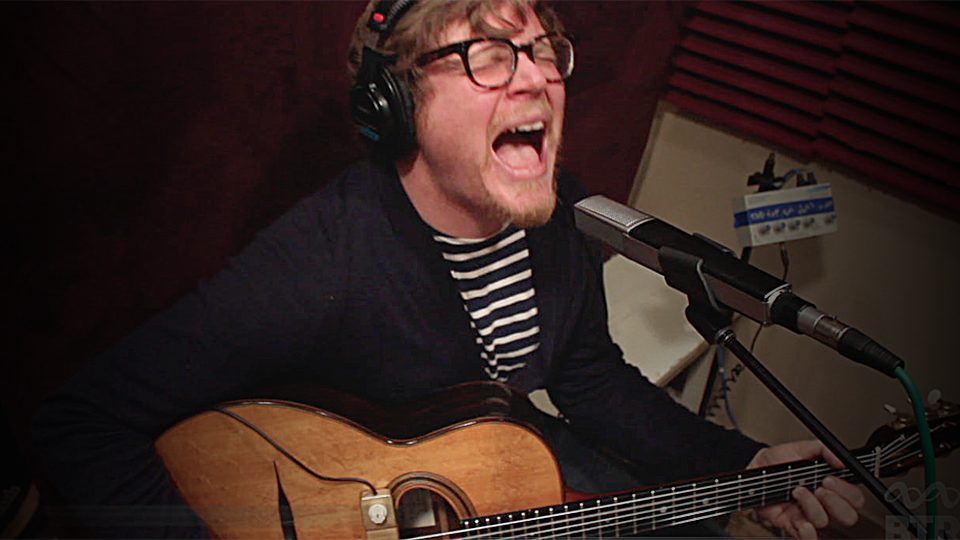
The Mind Behind the MegaFauna: An Interview With Noah Lit
After his indie rock band Oliver Future broke up, songwriter/vocalist/guitarist Noah Lit dug deep into his soul (a.k.a his record collection) to find a new direction. A mixture of Django chords with Mingus arrangements, atmospheric acoustic textures and apocalyptic lyrics, creates a curious intricate monster that sounds something like “Radiohead songs played in the 1930’s”. (more…)
Learn More
